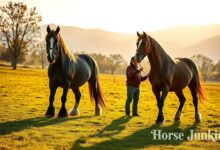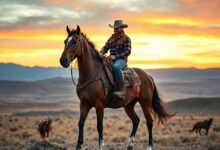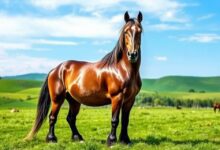Understanding Bay Color in Horses: A Guide
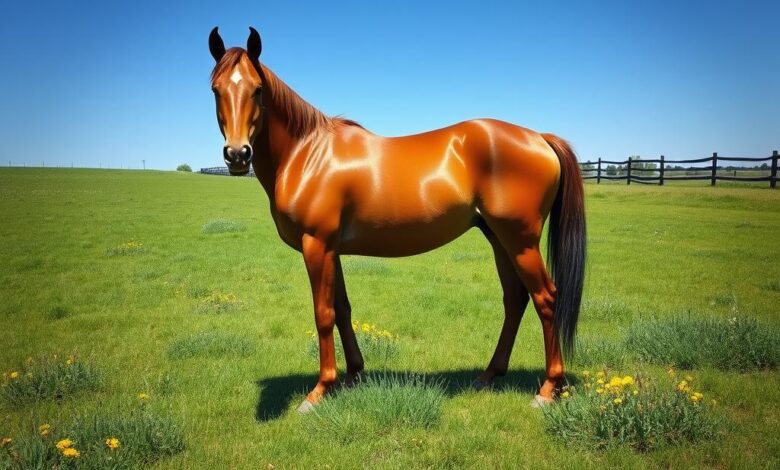
Did you know the bay color in horses is more than just a color? It’s a mix of genetics that makes them beautiful and unique. The bay color is known for its reddish-brown coat and black points on the mane, tail, and legs. In this guide, we’ll explore the bay color’s genetic roots, different shades, cultural importance, and how to care for them.
As we learn about bay horses, we want to share their beauty with everyone. Whether you’re an experienced horse lover or thinking of getting one, this guide is for you. It’s all about the amazing bay horse coat color.
Key Takeaways
- The bay color in horses is determined by the interaction of two genes: E (Extension) and A (Agouti).
- Bay horses are characterized by a reddish-brown coat with black points, offering a striking appearance.
- There are multiple variations of bay, including dark bay, blood bay, and copper bay, each with unique traits.
- Understanding the genetics behind bay color can help us appreciate the diversity of horse coat colors.
- Proper care and understanding of bay horses contribute to their health and well-being.
What Is Bay Color in Horses?
The bay color of horse is a favorite among horse lovers. It ranges from reddish-brown to dark brown. Bay horses have black points on their mane, tail, and legs, making them stand out.
Definition of Bay
Bay horses have a brown body with black points. They need specific genes to be bay. This results in a variety of shades, from light to dark.
Characteristics of Bay Horses
Bay horses have shiny coats that can be light red to deep brown. They always have black points on their mane, tail, and legs. Their color stays the same from birth to adulthood, helping to identify them.
Historical Significance
Bay horses have always been special. They were seen as symbols of strength and nobility. They were often with warriors and royalty, showing their importance in history.
Genetics Behind Bay Color
The bay color in horses comes from complex genetics. Learning about equine color genetics helps us see how this color appears. It shows us the important genes that decide a horse’s coat color.
Genetic Inheritance of Bay
The bay color comes from two key genes: the Extension locus (E) and the Agouti locus (A). A horse needs at least one E allele to have black pigment. This is key to understanding bay color.
Dominant and Recessive Genes
In horse color genetics, dominant and recessive genes are key. Black and bay horses have E/E or E/e genotypes, showing the E allele’s dominance. Chestnut horses, with a recessive trait, have e/e genotypes. This shows how different genes create different colors.
Role of the Agouti Gene
The Agouti gene is crucial for black pigment distribution. It decides if a horse is bay or black. Horses with A allele have bay color, while those with a allele are black. Knowing this makes us appreciate bay horses more.
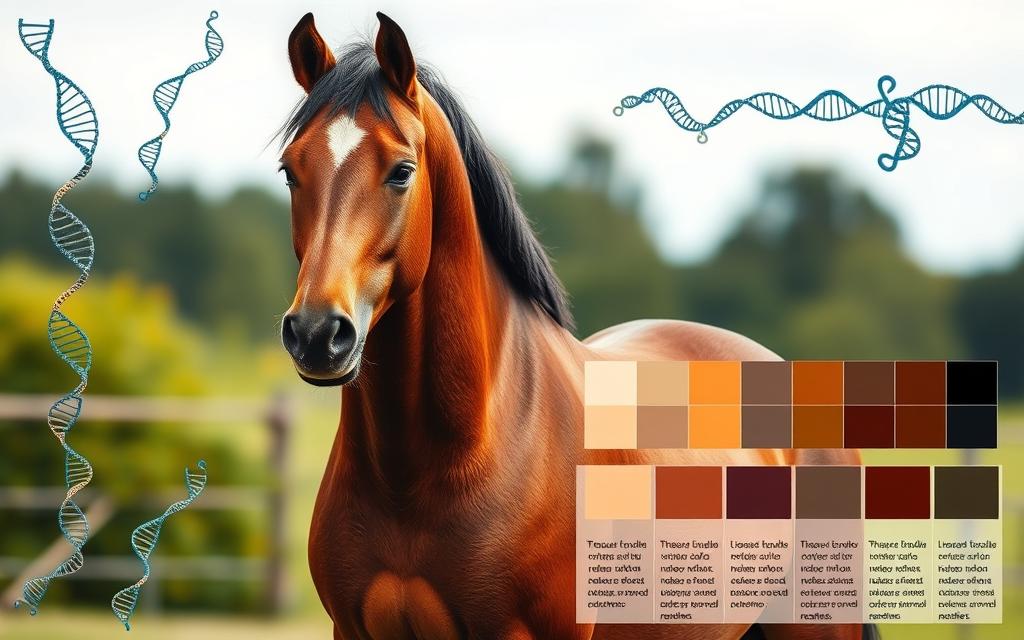
Variations of Bay Color
Bay horses come in a wide range of colors, showing the beauty and variety of this popular color. We see three main variations: Light Bay, Dark Bay, and Liver Bay. Each has its own special traits that attract different fans and breeders.
Light Bay
Light Bay has a light, golden color like soft caramel. It often shows golden undertones, making it very popular. These horses are known for their elegant looks and are often linked to certain bloodlines.
Dark Bay
Dark Bay, also called “brown,” is almost black but has deep reddish undertones. It has lighter hair around the face, eyes, and legs, creating a beautiful contrast. Dark Bay horses are loved for their rich color and striking features, making them a favorite among riders.
Liver Bay
Liver Bay has a deep, dark reddish-brown color, similar to mahogany. Its deep color grabs attention and suggests a strong genetic background. This variation adds depth to the world of horse colors and influences breeding practices.
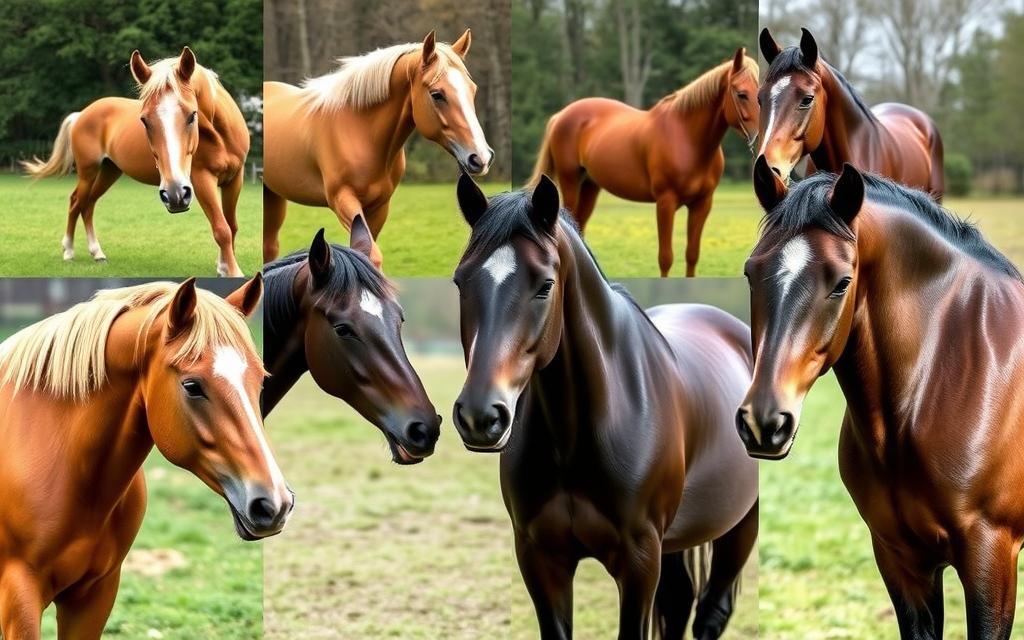
Common Misconceptions About Bay Horses
Learning about bay horses can clear up many common myths. The terms used to describe their colors can confuse people. This confusion makes it hard to truly appreciate these animals and their unique looks.
Distinguishing Bay from Other Colors
Many people mix up bay horses with brown or chestnut ones. Bay horses have a reddish-brown body with black points. Brown horses don’t have these points, and chestnuts have a reddish coat but no black points.
Myths About Breeds and Bay Color
There’s a myth that certain breeds are always bay-colored. But, many breeds can have bay colors, while others like Friesians or Haflingers usually don’t. This shows that bay markings aren’t tied to any one breed, highlighting the importance of understanding horse genetics and colors.
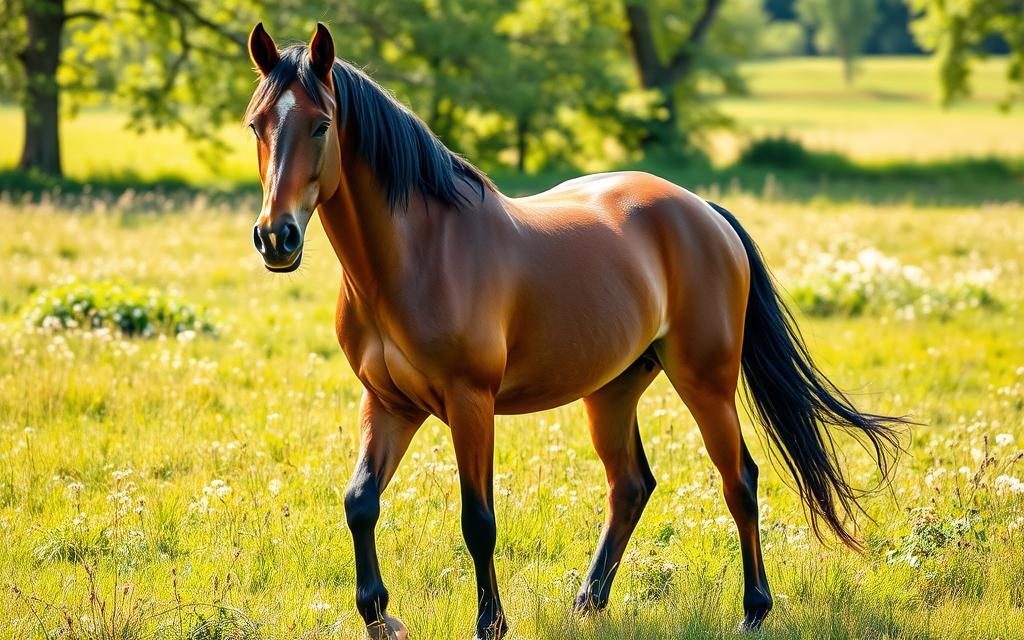
How to Care for Bay Horses
Caring for bay horses means paying attention to grooming. This helps keep their coat colors bright and their health good. By grooming, protecting from UV rays, and knowing about health issues, we keep our bay horses looking great and feeling well.
Grooming Tips for Bay Horses
Regular grooming keeps bay horse coats shiny. Use a soft-bristled brush to clean off dirt. This keeps their coat looking vibrant. A curry comb also helps, by stimulating the skin and spreading natural oils.
A well-groomed bay horse looks amazing and feels better too. It’s all about keeping their skin healthy.
UV Protection for Bay Coats
It’s important to protect bay horses from UV rays, especially for lighter shades. Sun can cause fading and skin problems. We can use fly sheets and UV-blocking sprays to keep their coats bright.
These steps help prevent sun damage. They also keep our horses healthy overall.
Common Health Considerations
Bay horses need special care for their health. Regular vet visits help catch skin issues and allergies early. Their coat type might make them more sensitive to some things.
Good food and supplements like copper and zinc help their coat stay healthy. Knowing about these health needs keeps our bay horses happy and healthy.
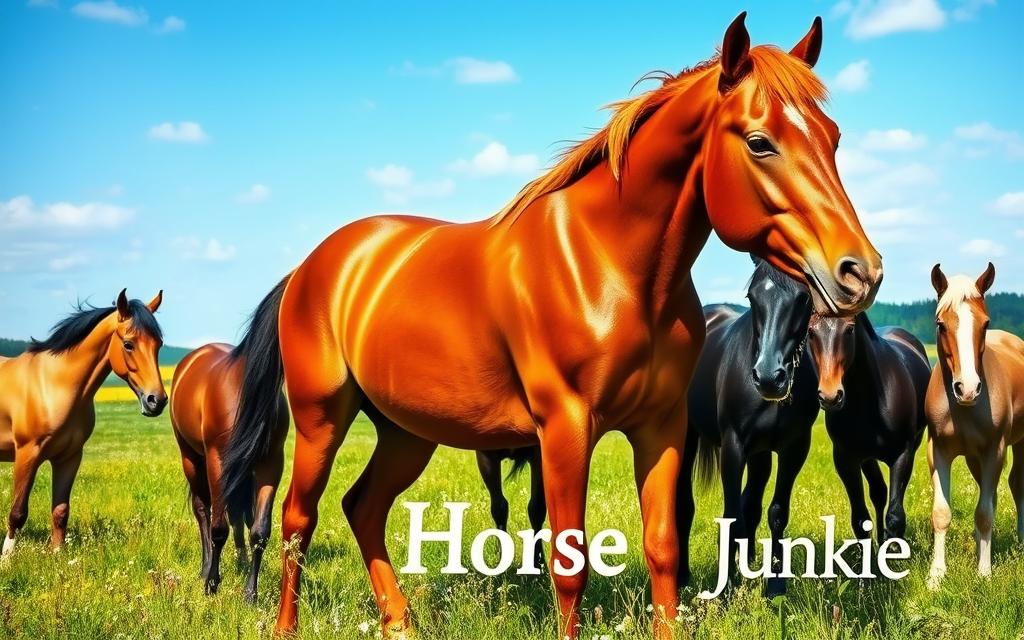
Bay Horses in Popular Culture
Bay horses in movies and books show their importance in stories. They stand for bravery and grace, perfect for heroes. Bay horses have won hearts in stories old and new, around the world.
Representation in Film and Literature
Bay horses have made a mark in books and movies. They’ve left us with unforgettable moments. Characters like Black Beauty and Boxer show our deep bond with them.
Characters like Shadowfax from literature show the noble side of bay horses. 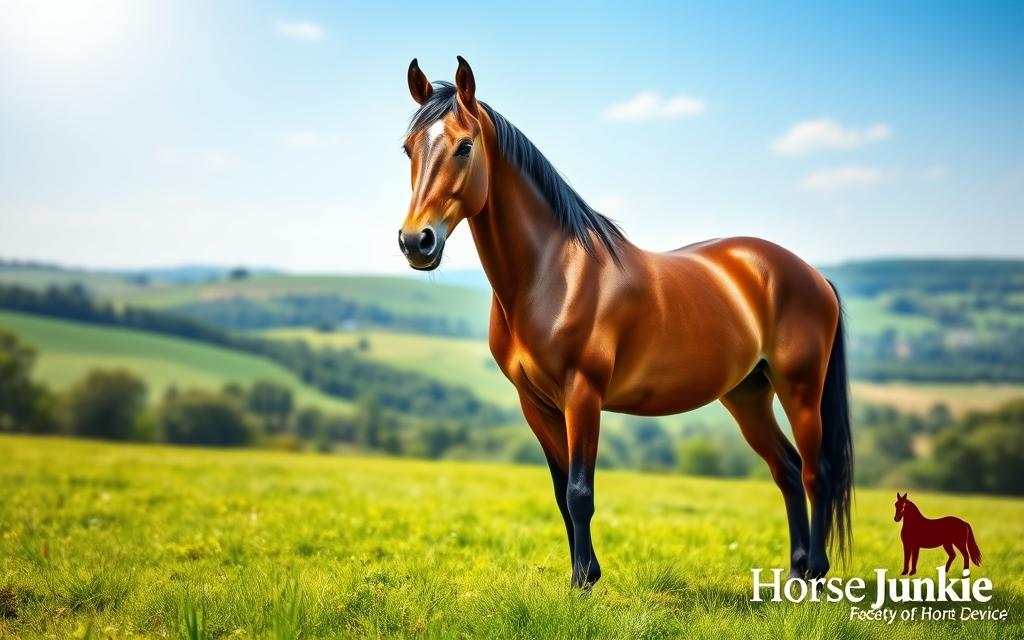
In movies, we see heroes like Artax from *The NeverEnding Story* and Maximus from *Gladiator*. They show the beauty of bay horses and our connection with them.
Famous Bay Horses in History
Bay horses have been by the side of famous people throughout history. They’ve become symbols of friendship and power. Their fame in stories and movies has made us love them even more.
Bay horses are known for their bravery and loyalty. They’ve captured our hearts in stories and movies. Their lasting impact reminds us of our special bond with them.
The Significance of Bay Color in Horse Breeding
Breeding bay horses requires deep knowledge of genetics. This knowledge helps us make better choices. It’s key for the beauty and value of bay horses.
Breeding Practices
Bay color comes from many genes. This affects how we breed horses. We love bay horses for their looks and skills.
Our methods include:
- Using tests to guess coat colors from matings.
- Looking at base color, dilution, and white spots in bloodlines.
- Tracking trends to find good genes.
Market Demand for Bay Horses
Bay horses are in high demand. People love their looks and performance. This drives breeders to create more bay horses.
Reasons for this demand are:
- Bay is popular in breeds like Paso Fino.
- Local tastes highlight special color lines.
- Some markets prefer flashy colors over solid bay.
Genetic research and testing have improved horse breeding. By choosing bay colors wisely, we ensure bay horses’ success in our field.
How to Identify a Bay Horse
To spot a bay horse, you need to know its special traits. Bay horses have a reddish-brown body with black markings on their mane, tail, and legs. Understanding horse colors helps us see the beauty in each horse.
Physical Characteristics to Look For
A bay horse has certain features:
- Body Color: It’s reddish-brown or dark brown, depending on the horse.
- Black Markings: You’ll see black on the mane, tail, and legs.
- Coat Patterns: The bay coat can look different in shade and intensity.
Comparing Bay with Other Colors
Knowing how to tell bay horses from others deepens our love for horses. Here are some comparisons:
- Chestnut: It’s solid reddish without black markings.
- Black: It’s all black, but rare because it’s a recessive color.
- Buckskin: It has a golden coat with black on legs, mane, and tail.
- Dun: It has a light base color with a dorsal stripe.
- Roan: It has white hairs mixed in, changing its look.
- Pinto: It has big color patches and white spots.
- Gray: It changes color over time, ending in white.
By paying close attention, we can see the unique details of bay horses. Learning about these traits helps us explore more about horse colors.
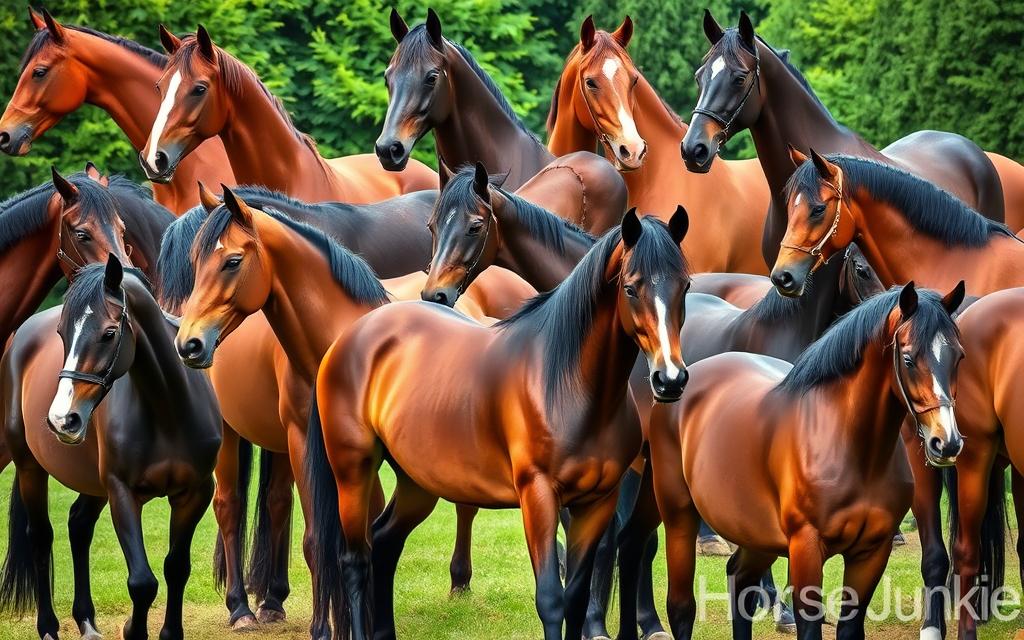
Training Considerations for Bay Horses
Understanding the unique traits of bay horses can improve our training. They mix confidence with sensitivity, needing tailored approaches. Tailoring our methods to each bay horse’s needs can enhance their learning and performance.
Behavioral Traits Specific to Bay Horses
Bay horses have distinct behaviors, including:
- Confidence: Many bay horses are very self-assured, especially in familiar places.
- Sensitivity: They are bold but also very aware of their surroundings and handlers. This makes clear communication key.
- Intelligence: Bay horses learn quickly. Using the right training strategies can help them grow.
Training Techniques That Work Well
To train bay horses well, we can use several effective techniques:
- Positive Reinforcement: Rewarding good behavior builds trust and creates a positive learning space.
- Consistent Routines: Regular routines make bay horses feel secure and help them understand expectations.
- Varied Exercises: Mixing up training, like ground work, agility, and riding drills, keeps them engaged and mentally active.
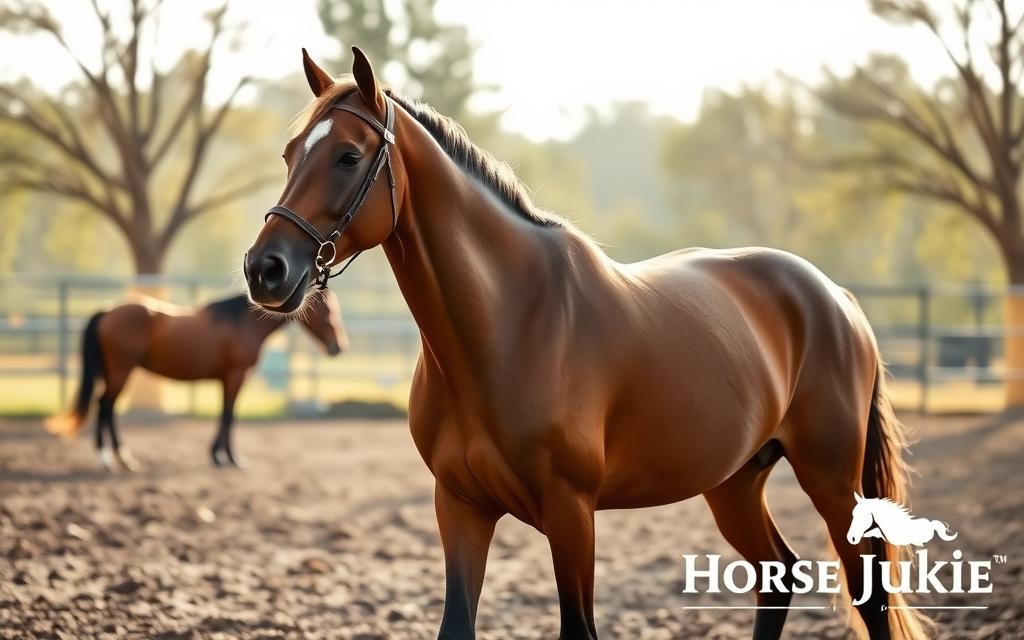
The Role of Bay Horses in Sports
Bay horses play a big role in sports. They are versatile, physically strong, and calm. This makes them perfect for many equestrian activities.
We see them shine in events like jumping, dressage, and racing. Their skills and athleticism are truly impressive.
Bay Horses in Equestrian Events
In equestrian competitions, bay horses are popular. They look great and perform well. Their calm nature helps them learn quickly.
They stand out because of their coat colors and athletic skills. This makes them excel in tough situations.
Popular Breeds Known for Bay Coloring
Some breeds are known for their bay colors, like the Thoroughbred and Cleveland Bay. The Thoroughbred is famous for racing. The Cleveland Bay is known for its strength and versatility in sports.
Bay horses, no matter the breed, are highly valued. They can cost a lot in the equestrian market. Their brownish-golden bodies and dark manes and tails make them even more attractive.
Nutritional Needs of Bay Horses
Proper nutrition is key for bay horses’ health. A balanced diet keeps them physically fit and their coats vibrant. We must consider their unique needs and health concerns.
Diet for Maintaining Coat Health
To keep their coats shiny, bay horses need certain vitamins and minerals. Important ones include:
- Vitamin A – essential for skin and coat health.
- Vitamin E – an antioxidant that contributes to coat shine.
- Biotin – crucial for improving coat quality.
- Copper and zinc – necessary for the manufacture of melanocytes, which provide color to bay coats.
Adding healthy fats to their diet is also beneficial. For example, 1/8 to 1/4 cup of oil can make their coats shine.
Supplements for Optimizing Shine
Supplements can also help improve their coat. Regular deworming is crucial to prevent parasites that harm nutrient absorption. Working with an equine nutritionist ensures they get the right nutrients.
Feeding EQUI-PRO® Calorie-Plus is a cost-effective way to support healthy skin and coat. Exercise is also important. It boosts blood flow, helping nutrients reach hair follicles. This approach helps keep bay horses’ coats looking rich and vibrant.
Conclusion: Appreciating the Beauty of Bay Horses
As we wrap up our look at bay horses, we see their deep history and cultural importance. Their bay color, with its reddish-brown and black points, is a sight to behold. It also helps us understand the wide range of horse colors.
Our Final Thoughts on Bay Coloring
Bay horses are common and loved by many. They have a special charm that draws people in. But, we must remember the big job of caring for them.
Learning about their needs, like food and health, is key. This keeps them happy and healthy.
Encouraging Responsible Ownership
Being a good owner is more than just loving bay horses. It’s about making sure they’re happy and healthy. This makes our time with them better, whether we’re just enjoying them or competing.
By caring for them, we also help the whole horse community. This makes our bond with them stronger and more meaningful.
FAQ
What distinguishes a bay horse from other horse colors?
Are bay horses susceptible to specific health issues?
How do the genetics of bay horses work?
What are the variations of bay horses?
What should I consider when caring for a bay horse?
Are bay horses more common in certain breeds?
Can the behavioral traits of bay horses vary?
How are bay horses represented in culture?
What impact does bay coloration have on breeding?
What nutrients are essential for a bay horse’s coat health?
Source Links
- 50 Shades of Bay Horses | Colors, Traits, & Fun Facts!
- A Comprehensive Guide to Common Horse Coat Colors
- What is a Bay Horse? Types, Colors, Shades and 10 Fun Facts!
- Bay Horses
- ‘Is my horse bay or brown in colour?’
- 6 Bay Horse Colors, Variations & Pictures | PangoVet
- Equine Coat Color Genetics 101
- Equine Coat Color Genetics
- Agouti (Bay/Black) | Veterinary Genetics Laboratory
- Bay Base Horse Coat Color
- Do horse coat colors affect their behavior?
- An Introduction to Equine Color Genetics
- Color & Conformation – Pryor Mountain – Wild Mustang Center
- A Horse of a Different Color: Common Equine Coat Colors!
- Prevent Horse Coat Bleaching
- List of fictional horses
- Off Topic Tuesday: 5 Random and/or Ridiculous Equine Pop Culture References – Eventing Nation – Three-Day Eventing News, Results, Videos, and Commentary
- Breeding a Horse of a Different Color: The Trends and Science Behind Horse Coloration
- How Your Horse Got His Color (And Why You Should Care)
- From grey to bay: How genetics plays a role in your horse’s coat colour
- NVAP Reference Guide: Equine Identification | Animal and Plant Health Inspection Service
- Horse Colors Explained – Five Star Ranch
- description and varieties of color, history of occurrence
- Cleveland Bay: Breed Profile
- Feeding for Coat Health
- Feeding for a Brilliant Coat Shine
- Diet for a horse, one that bleaches
- Understanding the Basics of Horse Colors: A Comprehensive Guide
- Exploring the Most Common Horse Coat Colors – Toll Booth Saddle Shop
- Bay Roan Horse: A Complete Guide to Their World – Horse World


